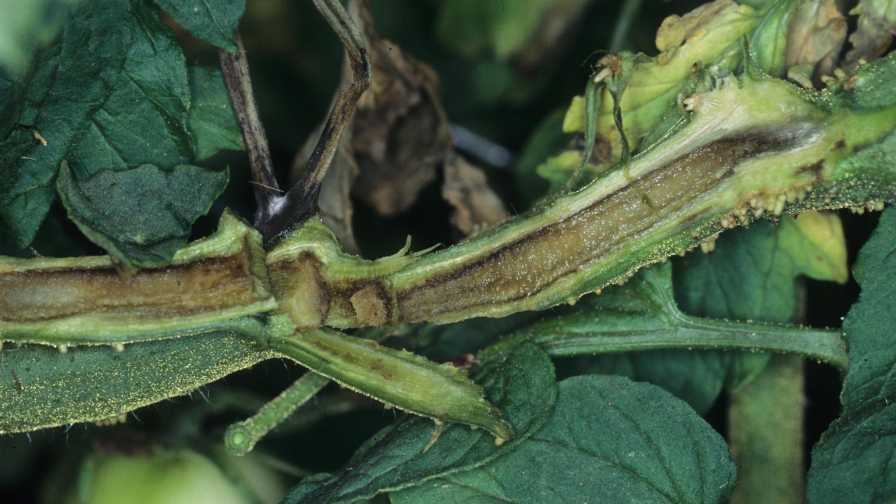Avoid Tomato Pith Necrosis Crisis in Your Crop

Hollowing and cracking of plant stems are one of the symptoms associated with tomato pith necrosis.
Photo by Gerald Holmes
Tomato pith necrosis is caused by the bacterium Pseudomonas corrugata, which is a weak pathogen that is able to attack rapidly growing tomato plants. While it typically occurs in greenhouses, it is being seen more regularly in field-grown tomatoes in Florida and the Southeast under certain conditions.
Identification
Initial symptoms of tomato pith necrosis typically include yellowing or chlorosis of young leaves and upper portion of the stem. Chlorosis often is accompanied by wilting, which develops in the upper portions of the plant along with necrosis of the lower stem when infection is severe.
Infected stems may not show external lesions, but the pith will gradually turn brown and necrotic. The stem might become chambered or hollow with a ladder-like appearance when split open length-wise.
This hollowing can lead to the cracking and breaking of the plant stems. Production of profuse adventitious roots often are associated pith necrosis. Although initial symptoms may look destructive, the disease might not progress. Fruit symptoms are rare and consist of greasy water-soaked blackened areas on the blossom end of the fruit.
Pith necrosis is most often observed when the first fruit set is close to mature green. The disease usually occurs randomly and is generally limited to a few plants.
Survival and Spread
In addition to P. corrugata, several other species of Pseudomonas can cause tomato pith necrosis. Pectobacterium carotovorum also can cause tomato pith necrosis.
Disease onset is favored by low night temperatures, high humidity, and high nitrogen. This pathogen is capable of growing in temperatures up to 100°F. Wounds and natural openings on the roots, stem, and base of the plant provide an entryway for the pathogen. Contaminated equipment and irrigation water can spread bacteria from plant to plant. Free water on stems and leaves promote infection, which develops when the first fruit set reach mature green stage. The bacterium may be transmitted to seed during fruit development.
Management Methods
Foliar symptoms of pith necrosis are similar to early bacterial canker disease symptoms and should not be used to confirm the disease. Symptomatic plants should be sampled immediately and submitted for plant disease diagnosis to rule out bacterial canker. Pith necrosis disease progression is slowed during warm and sunny periods, and plants will often recover from the disease once fertility conditions are corrected. The only strategy for managing pith necrosis is prevention by avoiding favorable conditions, such as excessive nitrogen application, especially in the spring when vegetative growth is rapid.
If possible, growers should delay planting in weather that is cool and wet as these environmental conditions favor the pith necrosis pathogens. Since the pathogens that cause pith necrosis can be introduced on contaminated crop debris, growers should avoid planting in fields with undecomposed tomato debris or which have been used to dump cull fruit.
Copper fungicides do not provide control because this soilborne bacterial pathogen is inside the plant.










